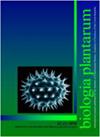富勒烯醇对玉米植株的影响取决于其铁含量
IF 0.9
4区 生物学
Q4 PLANT SCIENCES
引用次数: 2
摘要
铁(Fe)作为包括呼吸和光合作用在内的关键代谢过程的酶的辅助因子,对植物来说是必不可少的(Marschner 1995)。铁是地壳中含量丰富的元素。然而,在石灰性土壤的高pH值和高碳酸氢盐含量下,植物对铁的可用性往往会降低。生物可利用铁的缺乏导致了一种特征性的脱氯表型,这种表型在最年轻的叶片中开始发育。缺铁性黄化是一种影响植物的常见营养障碍,也是世界许多地区作物生产的主要限制因素之一(Vose 1982,Alloway 2008)。为了维持铁的稳态,植物已经进化出在有限的可用性条件下获取铁的机制。玉米和其他缺铁草一样,通过所谓的策略II对缺铁做出反应,其中包括1)释放植物铁载体(PS)以螯合土壤中的FeIII(三价铁)离子,以及2)在根细胞质膜中诱导FeIII-PS复合物的特异性转运蛋白(Römheld和Marschner 1986)。植物PS属于螯合剂的木甘酸(MA)家族(Hell和Stephan 2003)。针对Fe缺乏而增强的这种基于螯合的策略的两个反应都旨在提高Fe的吸收。在玉米中,Curie等人(2001)首次鉴定了编码FeIII-PS转运蛋白的黄条纹1(YS1)基因。有人认为玉米YS1(ZmYS1)参与了Fe和其他金属的初级Fe获取和细胞内运输本文章由计算机程序翻译,如有差异,请以英文原文为准。
Fullerenol affects maize plants depending on their iron status
Iron (Fe) is essential for plants as a co-factor of enzymes of key metabolic processes including respiration and photosynthesis (Marschner 1995). Iron is an element abundant in the earth’s crust. However, at high pH and high bicarbonate content of calcareous soils, the availability of Fe to plants is often reduced. The deficiency of bioavailable Fe leads to a characteristic chlorotic phenotype that begins to develop in the youngest leaves. Iron deficiency chlorosis is a common nutritional disorder affecting plants and one of the major limiting factors for crop production in many areas of the world (Vose 1982, Alloway 2008). To maintain Fe homeostasis, plants have evolved mechanisms to acquire Fe under conditions of limited availability. Maize, like other Fe-deficient grasses, respond to Fe deficiency through the so-called Strategy II, which includes 1) the release of phytosiderophores (PSs) for chelate FeIII (ferric) ions in soil and 2) the induction of a transporter specific for FeIII-PS complex in the root cell plasma membrane (Römheld and Marschner 1986). Plant PSs belong to the mugineic acid (MA) family of chelators (Hell and Stephan 2003). Both reactions of this chelationbased strategy enhanced in response to Fe deficiency are directed to improve Fe uptake. In maize, the Yellow Stripe 1 (YS1) gene encoding FeIII-PS transporter was firstly identified by Curie et al. (2001). It has been suggested that the maize YS1 (ZmYS1) is involved in both primary Fe acquisition and intracellular transport of Fe and other metals
求助全文
通过发布文献求助,成功后即可免费获取论文全文。
去求助
来源期刊

Biologia Plantarum
生物-植物科学
CiteScore
2.80
自引率
0.00%
发文量
28
审稿时长
3.3 months
期刊介绍:
BIOLOGIA PLANTARUM is an international journal for experimental botany. It publishes original scientific papers and brief communications, reviews on specialized topics, and book reviews in plant physiology, plant biochemistry and biophysics, physiological anatomy, ecophysiology, genetics, molecular biology, cell biology, evolution, and pathophysiology. All papers should contribute substantially to the current level of plant science and combine originality with a potential general interest. The journal focuses on model and crop plants, as well as on under-investigated species.
 求助内容:
求助内容: 应助结果提醒方式:
应助结果提醒方式:


